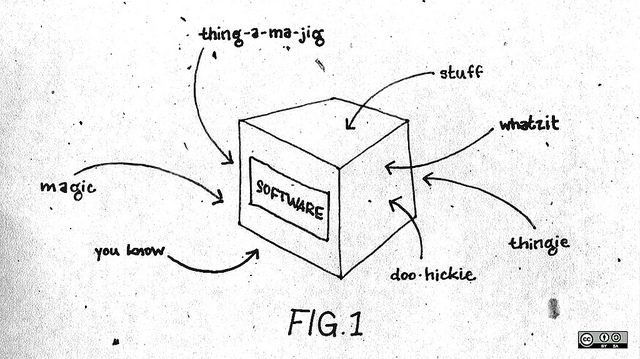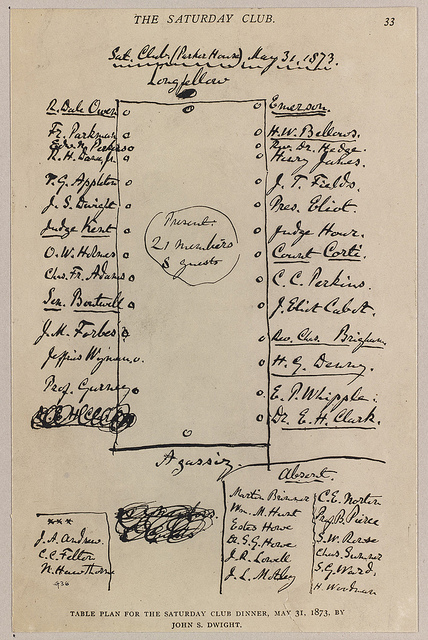How to Build a Drogulus
The drogulus is a programmable peer-to-peer data store. It's my "fun" programming project du jour and a thought experiment in code. This article is both a story of the drogulus and a high-level technical overview of what I'm attempting to build (I don't assume too much technical knowledge on the part of the reader).

The overriding aim of the drogulus is to simply promote the autonomy of its users. This aim informs all the technical choices outlined below.
What do I mean by autonomy (and why is it so important)?
When someone is autonomous they are self-directing, free to act of their own accord and lack imposition from others. Autonomy also suggests intelligence and awareness enough to be able to enjoy and make use of such freedom. Furthermore, such intelligence entails decision making so people become accountable for their actions. Autonomy is also the opposite of such undesirable states as tyranny, slavery, ignorance and apathy.
Unfortunately, many aspects of today's web are contrary to the promotion of user's autonomy:
- users are not in control of their data or online identity (websites act as walled gardens)
- to make the web work programmers have to use quirky and complicated technology defined in a top-down manner by committee (OAuth, CORS, Javascript date objects and Internet Explorer all spring to mind)
- there are many inadvertent points of control, lock-in and authority built into the web (DNS, the client/server model of the web and censorship by governments and other entities via "firewalls")
I asked myself, how would software designed to promote autonomy function? I tried to imagine the simplest possible solution, started to write code and the drogulus was born.
Three Pillars of the Drogulus
The client/server model of the web (where browsers [the clients] connect to websites [the servers and custodians of data]) is a fundamental problem simply because the server always has power over the client. Furthermore, the server is a single point of failure that is open to attack. So I decided to look at peer-to-peer (P2P) architectures as an antidote to such potential mechanisms of imposition and control. Typically, in a peer to peer network peers of equal status (computers running appropriate software) cooperate in a loose decentralised network for mutual benefit. Peer to peer is the antithesis of hierarchy (where some have elevated status and power over others as in the client/server model). Furthermore, the loose and decentralised organisation of computing resources make it very hard for third parties to control users. The drogulus is, in fact, many computers collaborating together over the internet.
Assuming a P2P architecture, what should users be able to do with such a resource? At a most fundamental level, users should be able to name things.
Being able to name things is a fundamental aspect of autonomy. In his work, "Pedagogy of the Oppressed", the philosopher Paulo Freire says,
to exist, humanly, is to name the world, to change it
Naming is a fundamental aspect of computing because it's a foundation for abstraction: naming a thing hides what it is or how it works, it is merely "X". Naming things (abstracting) is a way to make sense of the world. To be able to do so without imposition is liberating and an example of every-day autonomy.
Therefore, the drogulus is a data store: a place where knowledge is named and stored in its latent digital form as data. "Data" are simply values that convey meaningful information about something. Meaning is implied by the name, context and structure of the data. Structure is formed from the way data is represented. The drogulus is a data store because users are able to create, retrieve, update and delete named pieces of data. Importantly, once data is named it may also be referenced. This is the essential requirement for hypertext.
Data is latent. To make it useful you need to do something. In the digital realm that means programming. Programming is the creation and curation of instructions that produce results. Both programs and results may be stored as data in the drogulus. But what if you're not in control of the computer you're using or don't have access to a machine that's capable of running such programs? That's hardly an autonomous state. I want the drogulus to be trivially programmable ~ a sort of distributed programming environment. Imagine it as a re-configurable SETI@home on steroids: by running a node in the drogulus network you are sharing a small and highly controlled amount of your potential computing power with everyone else on the network.
Finally, users need to be able to trust the data found in the drogulus and be able to check its provenance. Furthermore, it should be possible to identify who's who (although the who aspect may be an anonymous nom de plume). On the web such things are dealt with by a central authority such as DNS (in the case of working out who a certain URL refers to), or services such as Google, Twitter and Facebook (when working out who's who on a social network). However, this is not a state of affairs that promotes autonomy. How can we make decisions based upon some piece of data without being able to check its provenance? The current centralised brokers of identity are yet another inadvertent point of control and authority. Furthermore, sometimes it is important to have the choice of becoming anonymous: you may face personal, political or economic retribution if certain data is connected with your offline identity. It is certainly an imposition to force the use of real names and identifiable data in order to use a digital service.
Is there an alternative?
Yes! By using public key cryptography to sign data the drogulus ensures the provenance of the data and that it has not been tampered with. Importantly, there is no central authority to prove who's who. Identity is built on the far more humane mechanism of a web of trust.
These aspects of promoting autonomy translate in to three technical "pillars" with which the drogulus is built:
- a distributed hash table provides a P2P data store
- a cryptographic layer based on public key cryptography is used to ensure the provenance and ownership of data
- A simple programming language called Logos (λόγος) uses the available computing power of the P2P network to compute results
Each of these pillars is described, in some detail, below.
Distributed Hash Tables
A distributed hash table (DHT) is a P2P key/value store. I suggest you look at my presentation given at this year's PyconUK for a quick introduction to DHT.

At a high level (a not entirely accurate analogy, although close enough for illustrative purposes) a distributed hash table works like a sort of peer-to-peer dictionary/encyclopedia: a unique key is used to identify (name) a value (the data). In a traditional dictionary/encyclopedia, the key is a word and the value is its definition or article. Being a data store, a distributed hash table allows users to create, retrieve, update and delete their own keys and associated digital values.
The hash table is distributed because it is split into the equivalent of the many volumes of a traditional encyclopedia (where each volume covers a particular part of the whole). Each person who ever uses the DHT has a copy of just one volume with many copies of a volume being distributed to many different users.
Users keep track of which of their friends on the network hold what volume. Users interact with the distributed hash table by contacting the friend with the correct volume for the desired item. If they don't know anyone with the right volume they play a sort of six-degrees-of-separation game with their friends and friends-of-friends until someone with the correct volume is found.
Distributed hash tables also share an interesting property with Bittorrent: the more popular an entry is the more widespread it becomes, thus improving performance since popular items are easier to find.
Distributed hash tables are eventually consistent (meaning changes made to the items stored in the DHT are not immediate: they may take some amount of time to propagate to relevant peers) and interactions with a DHT are asynchronous (the result may not be immediately available since the machinations of the six-degrees-of-separation game may take an unpredictable amount of time).
Nevertheless, distributed hash tables contain no single point of failure nor inadvertent point of control, scale to huge numbers of nodes, have a relatively efficient lookup procedure (the afore mentioned six-degrees-of-separation like process), are good at handling fluid network membership (nodes can be constantly joining and leaving the network) and have been tested in the real world (in projects such as Bittorrent, Freenet and others).
The drogulus's DHT is based upon but is not the same as the Kademlia distributed hash table algorithm. The innovation the drogulus brings is that keys and values are cryptographically signed in such a way that their provenance can be proven and content shown to be intact. Furthermore, users cannot interfere with each other's items stored within the distributed hash table unless they have access to the same private key.
Items are self contained and any that do not pass the cryptographic checks are ignored. Nodes that attempt to propagate such values are blocked (punished / ostracized) by their peers. The section about the cryptographic layer, below, explains how this works in greater detail.
The core aspects of a DHT are:
- generating keys within a finite "key space" (the set of all possible keys)
- keeping track of peers within the key space with a routing table
- discovering peers within a particular part of the key space with whom you interact to set and retrieve values (lookups and distance)
- ensuring the DHT performs well via caching, persisting data between nodes and keeping things up to date
- communicating asynchronously
These are explained below.
Key Space
A hash function is an algorithm that takes some arbitrary input block of data and turns it in to a fixed size output. Any change to the input data will change the resulting output. The name of the hash function currently used by the drogulus is SHA-512. Good hash functions are deterministic, cannot be reversed, generate different values from different seed data, uniformly distribute output values within the output range and attempt to avoid collisions (that are, unfortunately, inevitable).
Keys are SHA-512 values computed from two concatenated values provided by the user storing the data: their public key and a meaningful name identifying the item.
Every node in the DHT has a unique id that is also a SHA-512 value. This is computed from the node's own public key (used to facilitate communication with other nodes on the network). The public key is used as a seed for the hash to ensure a node has no way to position itself in a certain location in the range of all hashes.
Nodes store items whose keys are "close" to their ids (see the section on lookups and distance, below, for how this works). This isn't such a hard concept to understand: it's simply a way of knowing where a thing ought to be found, just like knowing that in an encyclopedia aardvark will be found in the volume containing entries for A.

Routing Table
The routing table is the data structure a node uses to keep track of its peers in the distributed hash table. It is a binary tree whose leaves are k-buckets.
A k-bucket lists contact information about other nodes in a particular region of the key space. The k-bucket is ordered from oldest to youngest node in terms of last connection time. None of the k-buckets overlap, but together they cover the whole key space.
A k-bucket can not contain more than K contacts - where K is a system wide replication parameter. K represents the number of nodes that are unlikely to fail within an hour of each other - typically, this value is set to 20.
Contact information consists of each peer's unique SHA-512 id within the DHT, its network address, the drogulus version the peer is running, a timestamp indicating when the last connection was made with the peer and a counter tracking the number of failed calls made from the local node to the peer represented by the contact.
When a node joins the network it starts with a routing table containing just a single k-bucket covering the whole key space. The routing table grows and changes dynamically as more peers are encountered or drop off the network.
When a new peer is encountered on the network the local node attempts to add it to the appropriate k-bucket that covers the area in the key space that the new peer's id falls in to. Initially this will be the original single k-bucket. If that k-bucket is not full (i.e. there are less than K contacts in it already) then the new peer's contact information is simply added.
If the k-bucket is full and its range includes the local node's ID then it is replaced by two new k-buckets each covering half the key space of the original (full) k-bucket. The contact information for peers originally held in the replaced k-bucket is divided between the two new k-buckets so peers are found in the correct new k-bucket. The new peer, whose insertion caused the split, has its contact information inserted in to the appropriate new k-bucket.
If the k-bucket covering the new peer is full and does not include the local node's id then its contact information is added to a replacement cache for the full k-bucket. If a peer in a full k-bucket has some arbitrary number of failed calls then it is removed from the k-bucket and the oldest member of the replacement cache that is still contactable is added to the k-bucket to replace it.
The routing-table is usually kept up-to-date by the normal network traffic between the local node and its peers. However, to guard against the odd case when network traffic has not refreshed all the k-buckets the local node will automatically refresh a k-bucket after some arbitrary amount of time (usually an hour) by picking a random ID within the range of the stale k-bucket and performing a node lookup for that ID (lookups are described below).
The local routing table may be asked for the K nearest peers to a certain SHA-512 id value. Sometimes it may return peers from different k-buckets if the desired id value is close to the "border" between k-buckets.

A helpful analogy for the routing table is that it's like a seating plan at a very large table where diners know more diners who are sat closer to them than further away.
Lookups and Distance
Every message between peers includes the SHA-512 node id of the sender. This permits peers to learn of each other's existence.
As has been mentioned before, keys are also SHA-512 values. To work out what nodes may store a given key a notion of distance is required. This allows the DHT to search for peers close to a target key and retrieve its associated value. Nodes found to be closest to the target key are used to store the target key/value item.
The DHT defines the distance between a node id and key as simply an integer representation of their bitwise exclusive or (XOR). This is both a simple and uniform measure of distance.
Given such a mechanism for measuring distance between keys and ids it is possible to navigate the DHT to look up keys and peers given a target SHA-512.
A lookup is an asynchronous operation that either calls back with a valid result or an "errback". It's also possible to define a timeout for the lookup in the drogulus's implementation of the DHT.
The lookup operation can be used to either find the K closest nodes to a particular target in the key space, in order to find candidate nodes that will store an item in the DHT, or retrieve a value for a given key likely to be found in a certain target area of the key space.
A lookup is both parallel (in that more than one request at a time can be made to fulfil the lookup) and recursive (in that such parallel requests return peers closer to the target that are re-used to request yet closer peers until a suitable result is found).
What follows is a brief description of the lookup algorithm.
The following values are used in the lookup implemented by the drogulus (some of the names are derived from the original Kademlia paper):
- the target key for the lookup
- the message type (either FindNode or FindValue)
- the routing table of the local node
- an ordered shortlist containing nodes close to the target
- a set of nodes that have been contacted during the lookup
- the id of the node nearest to the target (encountered so far)
- a dictionary of currently pending requests
- ALPHA - the number of concurrent asynchronous calls allowed
- K - the number of closest nodes to return when complete
- LOOKUP_TIMEOUT - the default maximum duration for a lookup
Given these values the lookup proceeds with the following steps:
- If "timeout" number of seconds elapse before the lookup is finished then cancel any pending requests and errback with an OutOfTime error. The "timeout" value can be overridden but defaults to LOOKUP_TIMEOUT seconds.
- Nodes from the local routing table seed the shortlist.
- The nearest node to the target in the shortlist is set as nearest node.
- No more than ALPHA nearest nodes that are in the shortlist but have not been contacted are sent a message that is an instance of the message type. Each request is added to the pending request dictionary. The number of pending requests must never be more than ALPHA.
- As each node is contacted it is added to the "contacted" set.
- If a node doesn't reply or an error is encountered it is removed from the shortlist and pending requests dictionary. Start from step 3 again.
- When a response to a request is returned successfully remove the request from the pending requests dictionary.
- If the lookup is for a FindValue message and a suitable value is returned (see note at the end of these comments) cancel all the other pending calls in the pending requests dictionary and fire a callback with the returned value. If the value is invalid remove the node from the short list and start from step 3 again without cancelling the other pending calls.
- If a list of closer nodes is returned by a peer add them to the short list and sort - making sure nodes in the "contacted" set are not mistakenly re-added to the shortlist.
- If the nearest node in the newly sorted shortlist is closer to the target than the current nearest node then set the nearest node to be the new closer node and start from step 3 again.
- If the nearest node remains unchanged DO NOT start a new call.
- If there are no other requests in the pending requests dictionary then check that the K nearest nodes in the "contacted" set are all closer than the nearest node in the shortlist. If they are, and it's a FindNode based lookup then call back with the K nearest nodes in the "contacted" set. If the lookup is for a FindValue message, errback with a ValueNotFound error.
- If there are still nearer nodes in the shortlist to some of those in the K nearest nodes in the "contacted" set then start from step 3 again (forcing the local node to contact the close nodes that have yet to be contacted).
Note on validating values: in the future there may be constraints added to the FindValue query (such as only accepting values created after time T).
To continue the (inaccurate yet friendly) dinner table analogy, a lookup is like asking people to pass the salt from the far end of the table. You ask a person you know sat closest to the salt pot, they introduce you to the next person they know sat even closer to the salt pot. This process continues until you get introduced to the person next to the salt pot who retrieves it for you.

(Nota Bene: please take these analogies with a pinch of salt.)
Caching, Persistence and "Uptodatedness"
Some items stored in the DHT will be more popular than others. It is possible to spread the effort for serving popular items to nodes other than those that originally stored the popular item. Furthermore, nodes can join or leave the DHT at any time. Items are persisted to new nodes and steps are taken to ensure there is no loss of data. Finally, items may be updated so it is important that newer versions replace older items.
The DHT achieves these objectives in the following way:
For caching purposes (to ensure the availability of popular items), once a FindValue lookup for an item succeeds, the requesting node stores the item at the closest node it observed to the target key that did not return the value. In this way the number of nodes storing the popular item grows and the distance from the target key to the most distant ids of nodes storing the popular item grows (so lookups find the item sooner since it's spread over a wider area of the key space that is "close" to the target key).
To guard against lost data and to ensure new nodes obtain items with keys close to their ids, nodes attempt to republish items every hour. This simply involves storing the item at the k currently closest nodes to the item's key. To avoid excessive network traffic a node will not persist the value if it has itself had the value republished to it within the hourly cycle.
To avoid over caching and before persisting an item this hourly process checks how close the item's key is to host node's own id and when the item was last requested. If they find the item has not been requested within the hour and its key is far away (some arbitrary distance that may change over time as the item becomes more out of date) then the item is removed from the local node. If the item is still "close enough" and within its expiry date then nodes within this area of the key space will continue to store the item no matter what.
If the item is found to have exceeded its expiry date then all nodes, no matter where they are in the key space, will delete the item.
Every item contains a creation date generated by the creator of the value to ensure more recent items take precedence over older versions that may be encountered in the network. If a node attempts to republish an old version of an item to a node with a more up-to-date version then the older version is replaced by the newer one and the republication activity is immediately repeated with the new (up-to-date) value.
Asynchronous Communication
All interactions with the DHT are asynchronous in nature and identified via a UUID used by all the nodes involved in the interaction. Locally, a promise (representing the interaction) is returned by the drogulus to the application layer. At some unknown time in the future the promise will either resolve with a result or an error (which may be a timeout if the interaction took too long).
Cryptographic Trust
The drogulus uses cryptography in two ways:
- Communication between nodes is encrypted
- Items stored in the DHT are cryptographically signed
It is important to note that this doesn't mean that values stored in the drogulus are encrypted. It simply means messages are sent in encrypted "digital envelopes" that can't be opened by third parties. The content of the envelopes may still be unencrypted. It is left to the user to manage the encryption of their data.
Both uses of cryptography use public key cryptography. If you're unsure what this means I've already written a blog post introducing public key cryptography.
Signing Items
Items stored in the distributed hash table are designed to stand on their own and be self-verifiable through cryptographic signing.
An item stored in the DHT is a collection of named fields and associated values:
- value - the actual value to store.
- timestamp - a UNIX timestamp representing when the creator of the item thinks the item was created (so it's easy to discern the latest version).
- expires - a UNIX timestamp beyond which the creator of the item would like the item to expire, be ignored and deleted.
- name - a meaningful name given by the creator for the key.
- meta - key/value strings for creator defined metadata about the item.
- created_with - the version of the protocol the creator used to generate the item.
- public_key - the creator's public key.
- sig - a cryptographic signature generated using the creator's private key with the value, timestamp, expires, name, meta and created_with values.
- key - the SHA-512 value of the compound key (based upon the public_key and name fields) used as the actual key on the distributed hash table.
The public_key field is used to validate the sig value. If this is OK then the compound SHA-512 key is checked using the obviously valid public_key and name fields.
This ensures both the provenance of the data and that it hasn't been tampered with. Any items that don't pass the cryptographic checks are ignored and nodes that propagate them are punished by being blocked. It also confirms that the generated SHA-512 key for the item is correct given the public_key and meaningful name ensuring no other entity may set items with this unique key (assuming no key collision vulnerability in the hashing function).
Logos / λόγος
Logos (say, "log-oss") is the least developed aspect of the drogulus and is likely to change quite a bit as development proceeds. As a result I only want to describe its requirements and how these relate to the over-arching aim of autonomy. It's all a bit "blue-sky" and "hand-wavey" at the moment but you'll at least get a flavour of what I'm thinking of implementing. Think of it as a raw "brain dump".
When I say that the drogulus is programmable I mean users are able to use the Logos language to manipulate data found in the drogulus (including Logos code too), save any results both locally and within the drogulus and either run such computations locally or remotely on other nodes on the network.
The Logos language should be simple enough for a ten year old to understand and find useful but powerful enough to be of interest to a professional programmer. There's no point promoting autonomy if the tool that users work with is incomprehensible.
Lisp-y
With the exception of Lisp, programmers have no control over how their language works and often find niggles that they wish they could change and usually long for features that may not ever be implemented. Why is Lisp different? Lisp is a programmable programming language: it is possible to bend Lisp to your own requirements and style of programming. There is no BDFL for Lisp who you have to convince to implement your changes. Using Lisp's macro system the programmer is free to enhance and change Lisp itself. The key is that Lisp is a homoiconic language: programs are expressed in the language's own data structures (in the case of Lisp, as lists).

Lisp is a simple yet very beautiful language - an opinion I try to justify in this blog post. An important realisation I've had is that Lisp like languages can act as the AST for other languages should the Lisp-y parenthesis-heavy syntax not appeal to programmers.
Such flexibility, simplicity and re-usability make a Lisp-like language a good candidate given my emphasis on autonomy. Therefore, Logos will be a small Lisp-like language that contains just enough simple features to make it useful and understandable to a ten year old yet, because it will be a programmable programming language, it should be powerful enough that professional programmers can build and share new more powerful features.
Remote Computation
Remember, Logos programs can be evaluated both locally or, if required, remotely.
To understand remote computation in the drogulus try to answer the following two questions:
- How can I tell if the result of my (remotely executed) program is correct?
- How do I ensure that I don't spend an inordinately expensive amount of my time and resources computing results for others?
Perhaps a story will help us ponder this problem...
If I find myself in an unfamiliar town and I require some information, say, directions to the cinema, then I have two choices: I can work out the answer (I'd consult a map and work out a route myself - assuming I have access to a map) or I could ask one of the locals - other people I find in this unfamiliar town - to tell me. Perhaps I already know a local and simply trust that they know the answer. Otherwise I usually find that "random" locals are very helpful and will give me a correct answer. However, sometimes locals are wrong because they don't know the correct answer themselves (they have a bug!). Alternatively, they're a nefarious sort who intentionally wants to send me on a wild goose chase and gives me wrong directions instead. Finally, I know that the locals have a reputation for abruptness - don't take up too much of their time or they will just tut loudly and walk off. As a result I ensure my request for information is both polite and to the point.
This story contains the essence of remotely executing code using the drogulus.
I could download the code from such-and-such a key and any data needed as input for the computation from such-and-such another key and run the Logos program on my local device. I'd only have to contend with bad data or buggy code (if that wasn't enough!). However, my device may not be powerful enough to run the program or the data may be huge making the download too expensive (the equivalent of not being able to find a map of the unfamiliar town). Why not get my peers to help me? This would involve working out the most efficient means of getting code and data to the same place so the computation can be executed and the result returned to me or stored someplace on the drogulus for me to retrieve later.
But what happens if the remote node executing code is intentionally trying to deceive. Ask yourself, if you had your doubts about the trustworthiness of the directions given to you in the unfamiliar town you'd probably ask a second or third local for directions and compare the answers. That's precisely what should happen for running a computation remotely. Ask n nodes for the result of the same computation, compare the results and, by consensus, discover, explore and select the answer. Such computations would be asynchronous and parallel in nature and, to increase confidence in the result, a higher value of n could be set. Since the nodes involved in the computation could be any (hopefully nice) node in the network individual nasty nodes would soon be out-voted. Furthermore, to hijack a computation an attacker would have to ensure that they controlled an inordinate number of nodes out of the potential pool of candidate nodes - an almost impossible task. Finally, unreliable nodes would face the threat of punishment via ostracism as already happens as part of the machinations of the DHT.
What if I'm to compute something? I oblige for the benefit of my fellow user of the drogulus (given that others do the same for me) but I set conditions in terms of time and space. I limit how long I'll spend computing a result and only allow myself to use a certain amount of memory. If these boundaries are hit then I respond with a message indicating such a situation has arisen.
You're mad! Stop before it's too late...
Nope. :-)
As I've mentioned elsewhere, I'm having too much fun to want to stop. What's the worse that could happen? I learn a lot of new and interesting stuff. That's no bad thing.
Apologies for the brain-dump nature of this post, but it's a good exercise to explain such things in a simple and understandable way. Constructive feedback, critique and comments most welcome via email.
Thanks for reading this far..!
Image credits: FIG 1. © 2011 Opensourceway (under a creative commons license). Encyclopedia Britannica © 2010 BostonTx (under a creative commons license). Aardvark © 2012 Valerie (under a creative commons license). Seating Plan © 2010 Boston Public Library (under a creative commons license). Salt pot © 2010 Alpha (under a creative commons license). Lisp Warning created by Conrad Barski, M.D. and released to the public domain.


